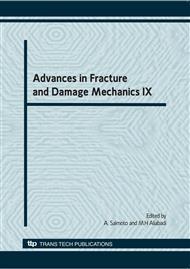p.369
p.373
p.377
p.381
p.385
p.389
p.393
p.397
p.401
Experimental Investigation and Numerical Simulation of Porous Volcano Rock Hypervelocity Impact on Whipple Shield of Spacecrafts
Abstract:
All spacecrafts in earth orbit are subject to hypervelocity impact by micro-meteoroids and space debris, which can in turn lead to significant damage and catastrophic failure of spacecraft. Porous volcano rock was adopted as one of micro-meteoroid material due to their similar physical and geometric features. Two-stage light gas gun experiments were carried out for a 6mm diameter volcano rock projectile impact on an Al-Whipple shield within the speed range from 1 km/s to 3 km/s. An ANSYS/LS-DYNA software was employed and justified by experimental results, in which a porous geometrical model was established for volcano rock projectile. The higher speed range was extended from 3 km/s to 10 km/s by numerical simulation. The results of experiments and numerical simulation indicated that major damage on rear wall of the Whipple shield impacted by volcano rock projectile is caused by the fragments of bumper of the shield, which is different from that of aluminum projectile. And 5.5km/s is the critical speed of a 6mm diameter volcano rock projectile impact on the Whipple shield investigated.
Info:
Periodical:
Pages:
385-388
Citation:
Online since:
November 2010
Authors:
Keywords:
Price:
Сopyright:
© 2011 Trans Tech Publications Ltd. All Rights Reserved
Share:
Citation:


